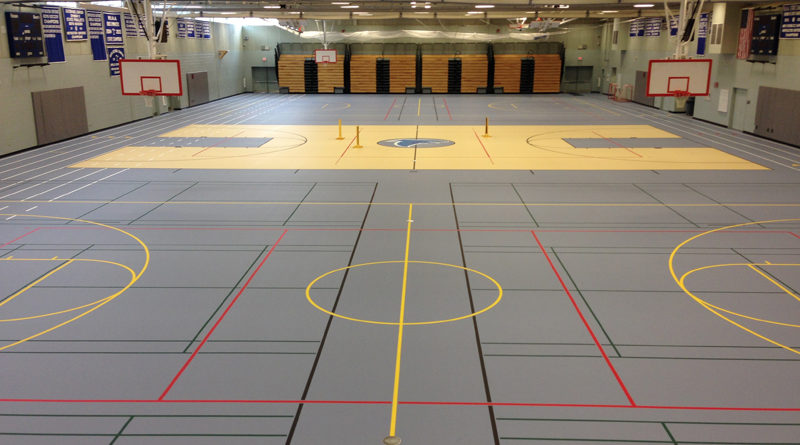Balancing Recreational Performance and Versatility with Synthetic Sports Floors
By Cory Corullo
The journey to find the right flooring for recreational spaces may feel like a daunting task with all the different flooring options and facility requirements.
It’s likely these spaces within your school may be used for sports- and non-sports related activities, which is why versatility, durability and ease of maintenance are all attributes to look for in addition to performance benefits for athletes.
By understanding common synthetic floor types, and why facility managers and athletic directors choose some over others, you will be able to make a well-informed synthetic flooring recommendation that will benefit everyone – down to athletes, students and the janitorial staff.
The Common Contenders
As a decision maker for flooring for recreational spaces, you may be considering materials such as carpeting, vinyl modular tile or vulcanized rubber for multi-purpose areas. These recreational spaces may include gyms that serve as a cafeteria or auditorium, or tennis and pickleball courts and weight rooms that double as spaces for activities in addition to their intended purpose.
Carpeting is sometimes used in multi-purpose areas. While it is an economical choice, it has significant downfalls. It is harder to keep clean and the fibers create a perfect environment for bacteria to grow and allergens to hide. Most importantly, it does not provide the proper surface friction for sports applications and rug burns are common.
Vinyl modular tile is a more common, inexpensive alternative. Minimal shock absorption can be added underneath; however, without an optional cushioned pad, it can be hard on athletes’ joints. Cleaning below the tiles is challenging and if not done, it can become a host for germ and mold growth. Yearly maintenance, as well as cracked tiles and loose tiles, are an ongoing nuisance.
A third option considered is vulcanized rubber flooring. Though it provides some shock absorbency, a concern with vulcanized rubber is that it must be completely replaced at end-of-life. Additionally, the fact that this floor has seams, means moisture and bacteria can soak into the floor, creating an unsanitary environment and causing the floor to degrade quicker.
For these reasons, we have found that the optimal synthetic sports floor is a padded polyurethane floor because it addresses the athletic and maintenance issues typically found in alternatives.
Where to Install Padded Polyurethane Floors and Why
Many schools find that padded polyurethane floors are a quality investment due to the versatility, durability and performance attributes. Padded polyurethane floors are comprised of a base mat with a polyurethane surface. This type of synthetic floor provides shock absorption, which is a critical flooring attribute facility managers and architects should look for when selecting and specifying a floor – it protects users’ joints and can help minimize injuries and fatigue. It’s something that coaches, athletic directors and rec center managers appreciate as well during class, activities and games.
Specific synthetic sports floor systems can withstand the abuse of heavy rolling loads providing a reasonably easy-to-maintain surface. Therefore, padded polyurethane floors are often selected for multi-purpose gymnasiums that double as a cafeteria or a gathering place for a multitude of events.
Outside of the gym, weight rooms are recreational spaces that reap the benefits of a seamless, non-porous floor option. Non-porous synthetic flooring, like a padded polyurethane floor, does not soak up the bacteria and perspiration of athletes. A spilled water bottle or sweat building up around a machine can make for more tedious clean-up work as this moisture soaks into porous floors. A non-porous system keeps moisture out and offers time-saving efficiencies for janitorial staff.
In weight room settings, durability is also a critical component. While most weight room floors offer acceptable protection for concrete, padded polyurethane floors can easily be resurfaced for longevity. The objective of weight room flooring is to protect the user, minimize noise, protect the equipment and reduce chipping of the concrete.
Many athletic directors and coaches are discovering the performance attributes of padded polyurethane for tennis courts outside of the common surfaces. Traditional tennis hardcourts have an asphalt or concrete base and are coated with an acrylic top coat, which does not offer shock absorption. Padded polyurethane cushioning is a much-appreciated characteristic to minimize injury and soreness of knees, hips and ankles, allowing for more comfortable playing and reduced recuperation times.
Finding the Best Synthetic System for Your School
There are many flooring solutions that work in schools and recreational centers of all sizes and purposes. Padded polyurethane floor systems provide users with comfortable cushioning, are durable and can be resurfaced. The non-porous characteristics also make maintenance an easier task than ever before.
To ensure you find the right floor for your project, take time to understand all considerations and requirements from both a short- and long-term perspective. Finally, work with a trusted and reputable flooring manufacturer that will guide you to find a synthetic sports floor system that makes things easier and more efficient for all the floor’s uses.
Cory Corullo is director of synthetic sales for Action Floor Systems.

